Evolution of Surge-Type Glaciers in the Yangtze River Headwater Using Multi-Source Remote Sensing Data
Abstract
:1. Introduction
2. Study Area
3. Data and Methods
3.1. Data
3.1.1. Landsat 5/7/8
3.1.2. ERS-2/ENVISAT
3.1.3. SRTM
3.2. Methods
3.2.1. The Method to Extract Glacial Flow Velocity
3.2.2. Extraction of Glacial Flow Velocity
4. Results
4.1. Glacier Centerline and Area
4.2. Glacier Flow Velocity
4.3. The Evolution of Glacial Centerline and Area
4.3.1. The Glacial Centerline Evolution
4.3.2. The Glacial Area Evolution
4.4. The Evolution of Glacial Flow Velocity
5. Discussion
6. Conclusions
- (1)
- By analysis and quantifying the centerline and area change evolution of Landsat series data from 1988 to 2018, we affirm that Glacier A, B, E are surge-type glaciers, and the active phase of surging glaciers are being, respectively, roughly locked. Combining with glacial flow velocities of SAR data from 1996 to 2010, the active periods are locked in 1997, 2003, and 1997–1998.
- (2)
- According to the results in this paper, combined with the concept of surging phenomenon and previous study experience, we suggest the three surges are dominated by hydrological conditions, which aims to keep a balance of inner glaciers.
Supplementary Materials
Author Contributions
Funding
Acknowledgments
Conflicts of Interest
References
- Crowley, T.J. Atmospheric circulation patterns during glacial inception: A possible candidate. Quat. Res. 1984, 21, 105–110. [Google Scholar] [CrossRef]
- Yao, T.D.; Li, Z.; Yang, W.; Guo, X.; Zhu, L.; Kang, S.; Wu, Y.; Yu, W. Glacial distribution and mass balance in the Yarlung Zangbo River and its influence on lakes. Chin. Sci. Bull. 2010, 55, 2072–2078. [Google Scholar] [CrossRef]
- Hoffman, M.; Price, S. Feedbacks between coupled subglacial hydrology and glacier dynamics. J. Geophys. Res. Earth Surf. 2014, 119, 414–436. [Google Scholar] [CrossRef]
- Raymond, C.F. How do glaciers surge? A review. J. Geophys. Res. Solid Earth 1987, 92, 9121–9134. [Google Scholar] [CrossRef]
- Meier, M.F.; Post, A. What are glacier surges? Can. J. Earth Sci. 2011, 6, 807–817. [Google Scholar] [CrossRef]
- Bolch, T.; Buchroithner, M.F.; Peters, J.; Baessler, M.; Bajracharya, S. Identification of glacier motion and potentially dangerous glacial lakes in the Mt. Everest region/Nepal using spaceborne imagery. Nat. Hazards Earth Syst. Sci. 2008, 8, 1329–1340. [Google Scholar] [CrossRef] [Green Version]
- Kääb, A.; Leinss, S.; Gilbert, A.; Bühler, Y.; Yao, T. Massive collapse of two glaciers in western Tibet in 2016 after surge-like instability. Nat. Geosci. 2018, 11, 114–120. [Google Scholar] [CrossRef] [Green Version]
- Wang, N.L.; Zhang, X.S. Mountain glacier fluctuations and climatic change during the last 100 years. J. Glaciol. Geocryol. 1992, 14, 242–250. [Google Scholar]
- Liu, C.; Tong, L.; Shengwen, Q.I.; Zhang, S.; Zheng, B. Remote sensing investigation and influence factor analysis of glacier lake outburst potential in the Himalayas. Remote Sens. Land Resour. 2016, 28, 110–115. [Google Scholar]
- Clarke, G.K.C.; Blake, E.W. Geometric and thermal evolution of a surge-type glacier in its quiescent state: Trapridge Glacier, Yukon Territory, Canada, 1969–1989. J. Glaciol. 1991, 37, 158–169. [Google Scholar] [CrossRef] [Green Version]
- Sevestre, H.; Benn, D. Climatic and topographic controls on the distribution of surge-type glaciers: Implication for a unifying model of surging. In AGU Fall Meeting Abstracts; American Geophysical Union: Washington, DC, USA, 2014. [Google Scholar] [CrossRef]
- Robin, G.D.Q.; Weertman, J. Cyclic Surging of Glaciers. J. Glaciol. 1973, 12, 3–18. [Google Scholar] [CrossRef] [Green Version]
- Dowdeswell, J.A.; Hamilton, G.S.; Ove, H.J. The duration of the active phase on surge-type glaciers: Contrasts between Svalbard and other regions. J. Glaciol. 1991, 37, 388–400. [Google Scholar] [CrossRef] [Green Version]
- Hambrey, M.J.; Dowdeswell, J.A.; Murray, T. Thrusting and debris entrainment in a surging glacier: Bakaninbreen, Svalbard. Ann. Glaciol. 1996, 22, 241–248. [Google Scholar] [CrossRef]
- Kamb, B.; Raymond, C.F.; Harrison, W.D.; Engelhardt, H.; Echelmeyer, K.A.; Humphrey, N.; Brugman, M.M.; Pfeffer, T. Glacier Surge Mechanism: 1982-1983 Surge of Variegated Glacier, Alaska. Science 1985, 227, 469–479. [Google Scholar] [CrossRef] [PubMed] [Green Version]
- Kotlyakov, V.M.; Osipova, G.B.; Tsvetkov, D.G. Fluctuations of unstable mountain glaciers: Scale and character. Ann. Glaciol. 1996, 24, 338–343. [Google Scholar] [CrossRef] [Green Version]
- Clarke, G.K.C. Fast glacier flow: Ice streams, surging, and tidewater glaciers. J. Geophys. Res. Solid Earth 2012, 92, 8835–8841. [Google Scholar] [CrossRef]
- Kotlyakov, V.M.; Osipova, G.B.; Tsvetkov, D.G. Monitoring surging glaciers of the Pamirs, central Asia, from space. Ann. Glaciol. 2008, 48, 125–134. [Google Scholar] [CrossRef] [Green Version]
- Quincey, D.J.; Luckman, A.; Benn, D. Quantification of Everest region glacier velocities between 1992 and 2002, using satellite radar interferometry and feature tracking. J. Glaciol. 2009, 55, 596–606. [Google Scholar] [CrossRef] [Green Version]
- Goldstein, R.M.; Engelhardt, H.; Kamb, B.; Frolich, R.M. Satellite Radar Interferometry for Monitoring Ice Sheet Motion: Application to an Antarctic Ice Stream. Science 1993, 262, 1525–1530. [Google Scholar] [CrossRef]
- Budd, W.F. A First Simple Model for Periodically Self-Surging Glaciers. J. Glaciol. 2017, 14, 3–21. [Google Scholar] [CrossRef]
- Lovell, A.M.; Carr, J.R.; Stokes, C.R. Topographic controls on the surging behaviour of Sabche Glacier, Nepal (1967 to 2017). Remote Sens. Environ. 2018, 210, 434–443. [Google Scholar] [CrossRef] [Green Version]
- Bhambri, R.; Hewitt, K.; Kawishwar, P.; Pratap, B. Surge-type and surge-modified glaciers in the Karakoram. Sci. Rep. 2017, 7. [Google Scholar] [CrossRef] [PubMed]
- Rashid, I.; Abdullah, T.; Glasser, N.F.; Naz, H.; Romshoo, S.A. Surge of Hispar Glacier, Pakistan, between 2013 and 2017 detected from remote sensing observations. Geomorphology 2018, 303, 410–416. [Google Scholar] [CrossRef] [Green Version]
- Steiner, J.F.; Kraaijenbrink, P.D.A.; Jiduc, S.G. Brief communication: The Khurdopin glacier surge revisited – extreme flow velocities and formation of a dammed lake in 2017. Cryosphere 2018, 12, 95–101. [Google Scholar] [CrossRef] [Green Version]
- Schneevoigt, N.J.; Sund, M.; Bogren, W. Glacier displacement on Comfortlessbreen, Svalbard, using 2-pass differential SAR interferometry (DInSAR) with a digital elevation model. Polar Rec. 2012, 48, 17–25. [Google Scholar] [CrossRef]
- Fatland, D.R.; Lingle, C.S. Analysis of the 1993–1995 Bering Glacier (Alaska) surge using differential SAR interferometry. J. Glaciol. 1998, 44, 532–546. [Google Scholar] [CrossRef] [Green Version]
- Strozzi, T. Glacier motion estimation using SAR offset-tracking procedures. Geosci. Remote Sens. IEEE 2002, 40, 2384–2391. [Google Scholar] [CrossRef] [Green Version]
- Forster, R.R.; Jezek, K.C.; Koenig, L. Measurement of glacier geophysical properties from InSAR wrapped phase. IEEE Trans. Geosci. Remote Sens. 2003, 41, 2595–2604. [Google Scholar] [CrossRef]
- Ke, L.; Xiaoli, D.; Wenkai, L.; Bo, Q. Remote Sensing of Glacier Change in the Central Qinghai-Tibet Plateau and the Relationship with Changing Climate. Remote Sens. 2017, 9, 114. [Google Scholar] [CrossRef] [Green Version]
- Wang, Z.; Huian, Y. Characteristics of the distribution of glaciers in China. Ann. Glaciol. 2001, 16, 17–20. [Google Scholar]
- Liu, C.H.; Shi, Y.F.; Wang, Z.T.; Xie, Z.C. Glacier Resources and Their Distributive Characteristics in China—A Review on Chinese Glacier Inventory. J. Glaciol. Geocryol. 2000, 22, 106–112. [Google Scholar]
- Jiang, J. Primary analyse of water resource, disasters and environment in the Changjiang river catchment. Quat. Sci. 2004, 24, 512–517. [Google Scholar]
- Dai, S.; Yang, S. Variations in Water Resources of the Yangtze River over the Last Five Decades. J. Nat. Resour. 2006, 21, 501–506. [Google Scholar]
- Jiang, G.; Han, B.; Gao, Y.; Yang, C. Review of 40-year earth observation with Landsat series and prospects of LDCM. J. Remote Sens. 2013, 17, 1033–1048. [Google Scholar]
- Andreassen, L.M.; Paul, F. The new Landsat-derived glacier inventory for Jotunheimen, Norway, and deduced glacier changes since the 1930s. Cryosphere 2008, 2, 131–145. [Google Scholar] [CrossRef] [Green Version]
- Edwards, S.; Moore, P.; King, M. A Comparison of ERS-2/ENVISAT and TOPEX/JASON-1 Tropospheric Zenith Wet Delay Measurements with Estimates from Offshore GPS Data. In AGU Fall Meeting Abstracts; American Geophysical Union: Washington, DC, USA, 2003. [Google Scholar]
- Rignot, E.J.M.; van Zyl, J.J. Change detection techniques for ERS-1 SAR data. IEEE Trans. Geosci. Remote Sens. 1993, 31, 896–906. [Google Scholar] [CrossRef] [Green Version]
- Tian, X. Large-scale forest mapping based on ERS-1/2 and Envisat ASAR data. J. Beijing For. Univ. 2013, 35, 7–15. [Google Scholar]
- Surazakov, A.B.; Aizen, V.B. Estimating volume change of mountain glaciers using SRTM and map-based topographic data. IEEE Trans. Geosci. Remote Sens. 2006, 44, 2991–2995. [Google Scholar] [CrossRef]
- Benjamin, A.B. Automated classification of debris-covered glaciers combining optical, SAR and topographic data in an object-based environment. Remote Sens. Environ. 2015, 170, 372–387. [Google Scholar]
- Chander, G.; Markham, B.L.; Helder, D.L. Summary of current radiometric calibration coefficients for Landsat MSS, TM, ETM+, and EO-1 ALI sensors. Remote Sens. Environ. 2009, 113, 893–903. [Google Scholar] [CrossRef]
- Wang, G.; Zhang, T.; Zhang, J.; Hua, W.U.; Yang, Q.; Xiyou, G.E. Comparative Study of Glaciers Information Extraction Method Based on Remote Sensing Image. Geospat. Inf. 2010, 8, 43–46. [Google Scholar]
- Luckman, A.; Quincey, D.; Bevan, S. The potential of satellite radar interferometry and feature tracking for monitoring flow rates of Himalayan glaciers. Remote Sens. Environ. 2007, 111, 172–181. [Google Scholar] [CrossRef]
- Huang, L.; Li, Z. Comparison of SAR and optical data in deriving glacier velocity with feature tracking. Int. J. Remote Sens. 2011, 32, 2681–2698. [Google Scholar] [CrossRef]
- Guo, H. Glacier surface velocity estimation in the West Kunlun Mountain range from L-band ALOS/PALSAR images using modified synthetic aperture radar offset-tracking procedure. J. Appl. Remote Sens. 2013, 8. [Google Scholar] [CrossRef] [Green Version]
- Yan, S.; Guo, H.; Liu, G.; Ruan, Z. Mountain glacier displacement estimation using a DEM-assisted offset tracking method with ALOS/PALSAR data. Remote Sens. Lett. 2013, 4, 494–503. [Google Scholar] [CrossRef]
- Yan, S.; Liu, G.; Wang, Y.; Perski, Z.; Ruan, Z. Glacier surface motion pattern in the Eastern part of West Kunlun Shan estimation using pixel-tracking with PALSAR imagery. Environ. Earth Sci. 2015, 74, 1871–1881. [Google Scholar] [CrossRef]
- Jia, L.; Li, Z.W.; Wang, C.C.; Zhu, J.J.; Ding, X.L. Using SAR offset-tracking approach to estimate surface motion of the South Inylchek Glacier in Tianshan. Chin. J. Geophys. 2013, 56, 1226–1236. [Google Scholar]
- Nuth, C.; Schuler, T.V.; Kohler, J.; Altena, B.; Hagen, J.O. Estimating the long-term calving flux of Kronebreen, Svalbard from geodetic elevation changes and mass-balance modelling. J. Glaciol. 2012, 58, 119–133. [Google Scholar] [CrossRef] [Green Version]
- Lv, M.; Lu, X.; Guo, H.; Liu, G.; Ding, Y.; Ruan, Z.; Ren, Y.; Yan, S. A rapid glacier surge on Mount Tobe Feng, western China, 2015. J. Glaciol. 2016, 62, 1–3. [Google Scholar] [CrossRef] [Green Version]
- Liu, G.; Guo, H.; Yan, S.; Song, R.; Ruan, Z.; Lv, M. Revealing the surge behaviour of the Yangtze River headwater glacier during 1989–2015 with TanDEM-X and Landsat images. J. Glaciol. 2017, 63, 382–386. [Google Scholar] [CrossRef] [Green Version]
- Fowler, A.C.; Murray, T.; Ng, F.S.L. Thermally controlled glacier surging. J. Glaciol. 2017, 47, 527–538. [Google Scholar] [CrossRef] [Green Version]
- Dunse, T.; Schellenberger, T.; Kaab, A.; Schuler, T.V. Glacier-surge mechanisms promoted by a hydro-thermodynamic feedback to summer melt. Cryosphere 2015, 9, 197–215. [Google Scholar] [CrossRef] [Green Version]
- Quincey, D.J.; Glasser, N.F.; Cook, S.J.; Luckman, A. Heterogeneity in Karakoram glacier surges. J. Geophys. Res. Earth Surf. 2015, 120, 1288–1300. [Google Scholar] [CrossRef] [Green Version]
- Hewitt, K. Tributary glacier surges: An exceptional concentration at Panmah Glacier, Karakoram Himalaya. J. Glaciol. 2017, 53, 181–188. [Google Scholar] [CrossRef] [Green Version]
- Lv, M.; Guo, H.; Lu, X. Characterizing the behaviour of surge- and non-surge-type glaciers in the Kingata Mountains, eastern Pamir, from 1999 to 2016. Cryosphere 2019, 13, 219–236. [Google Scholar] [CrossRef] [Green Version]
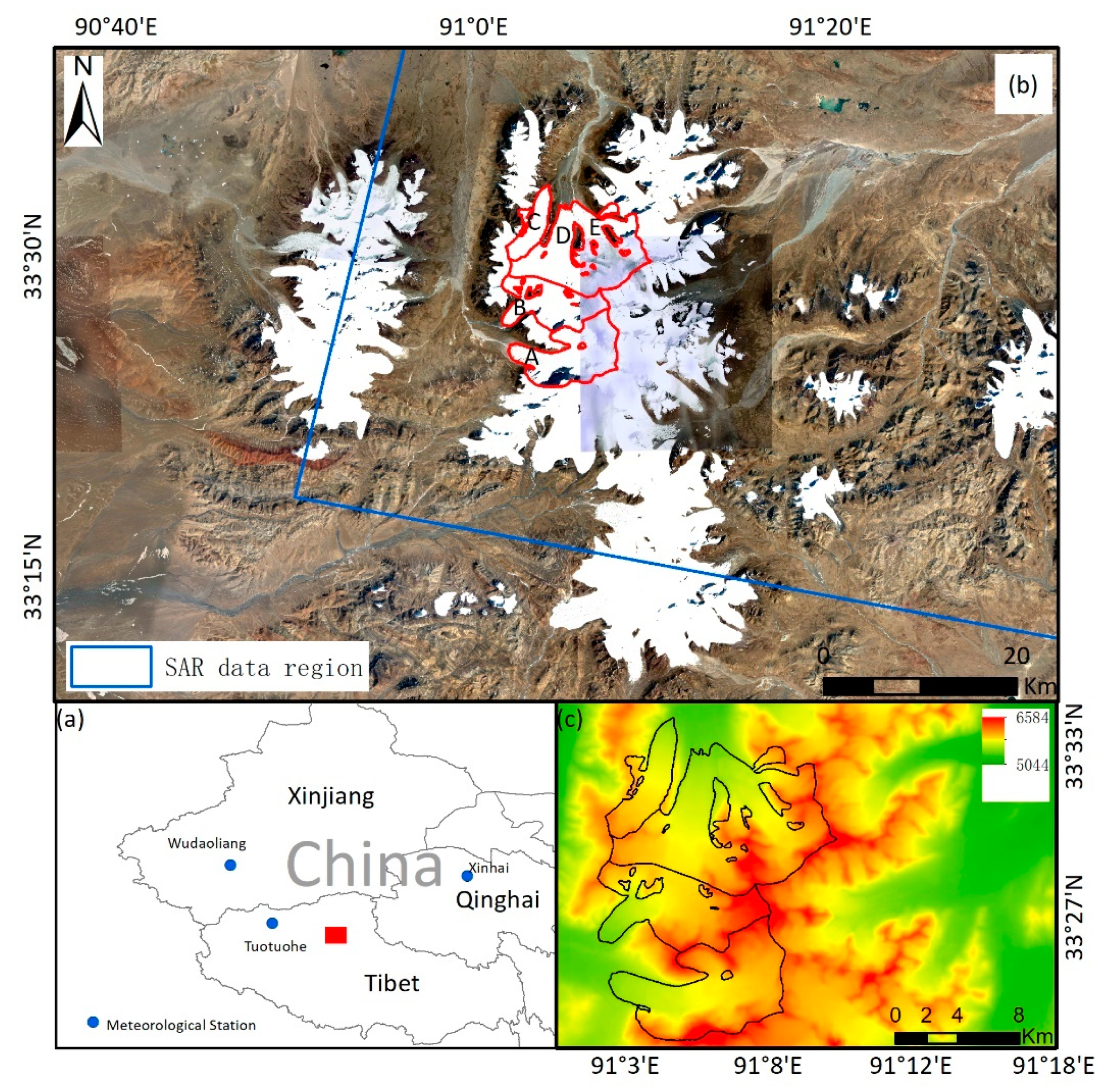
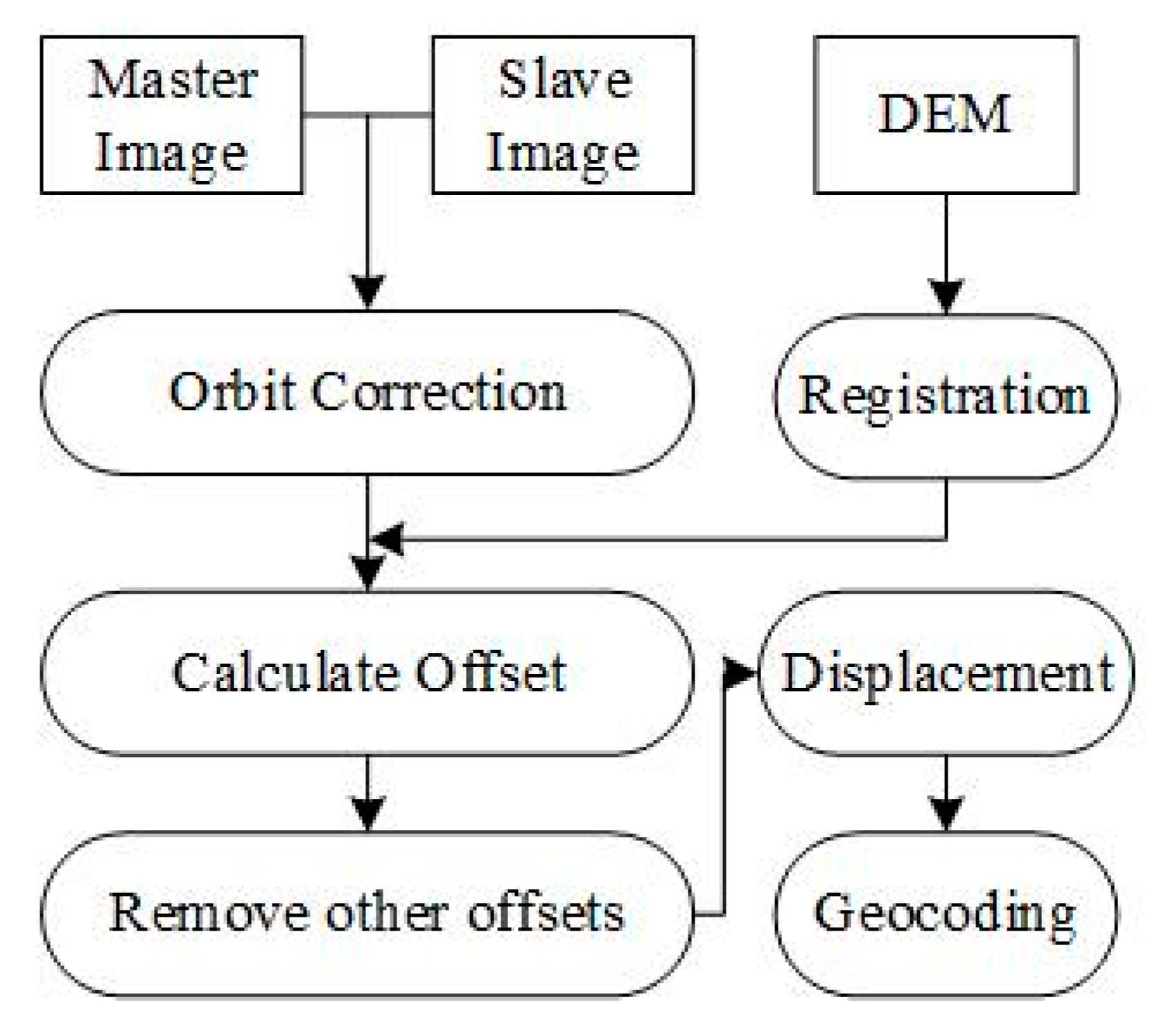
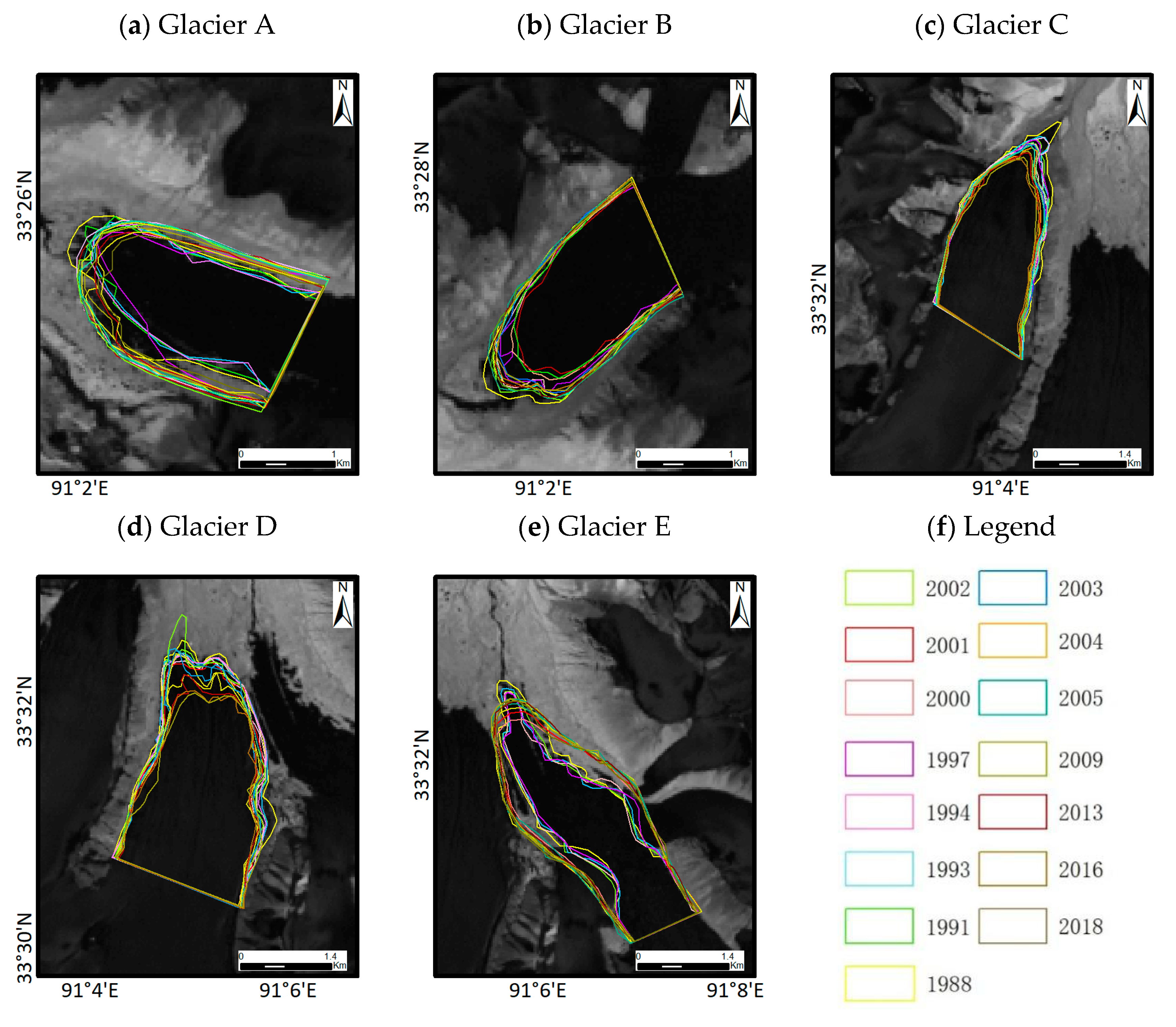
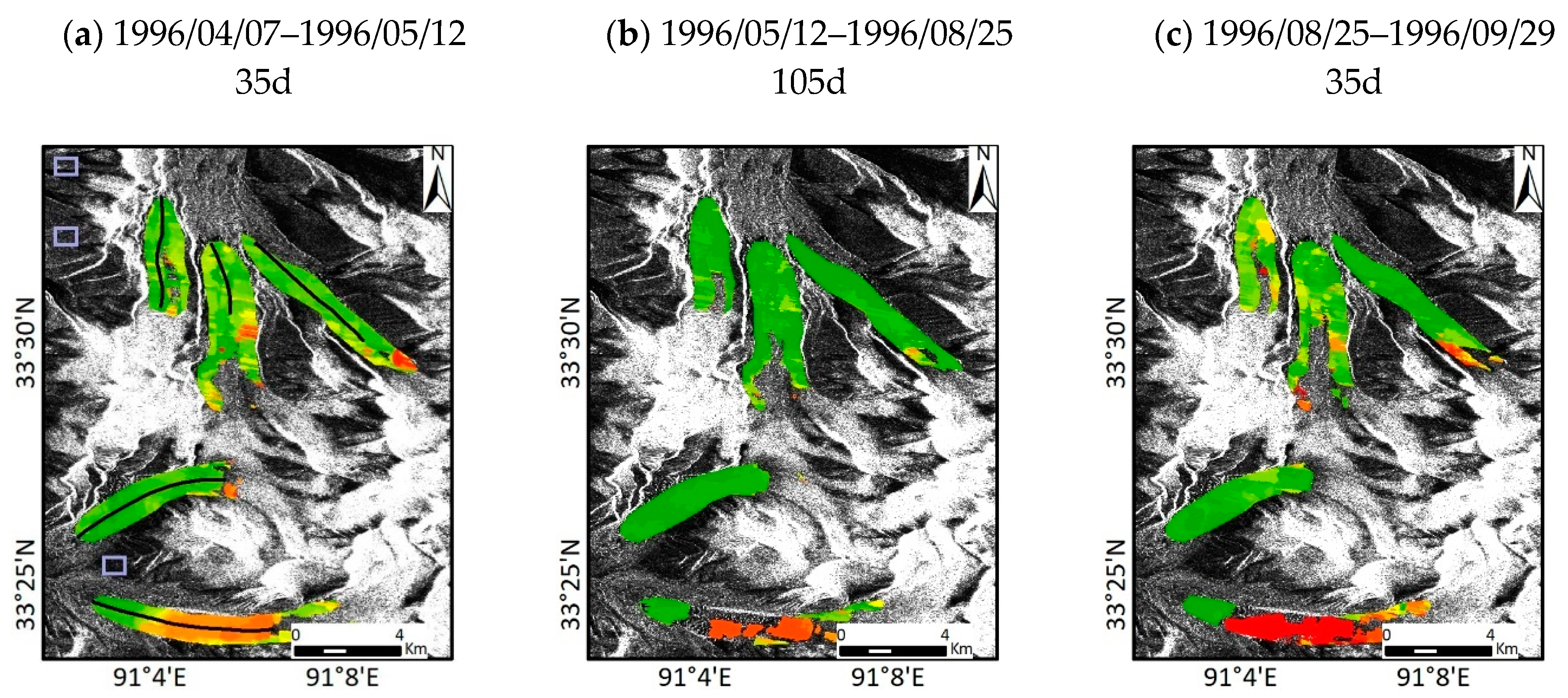
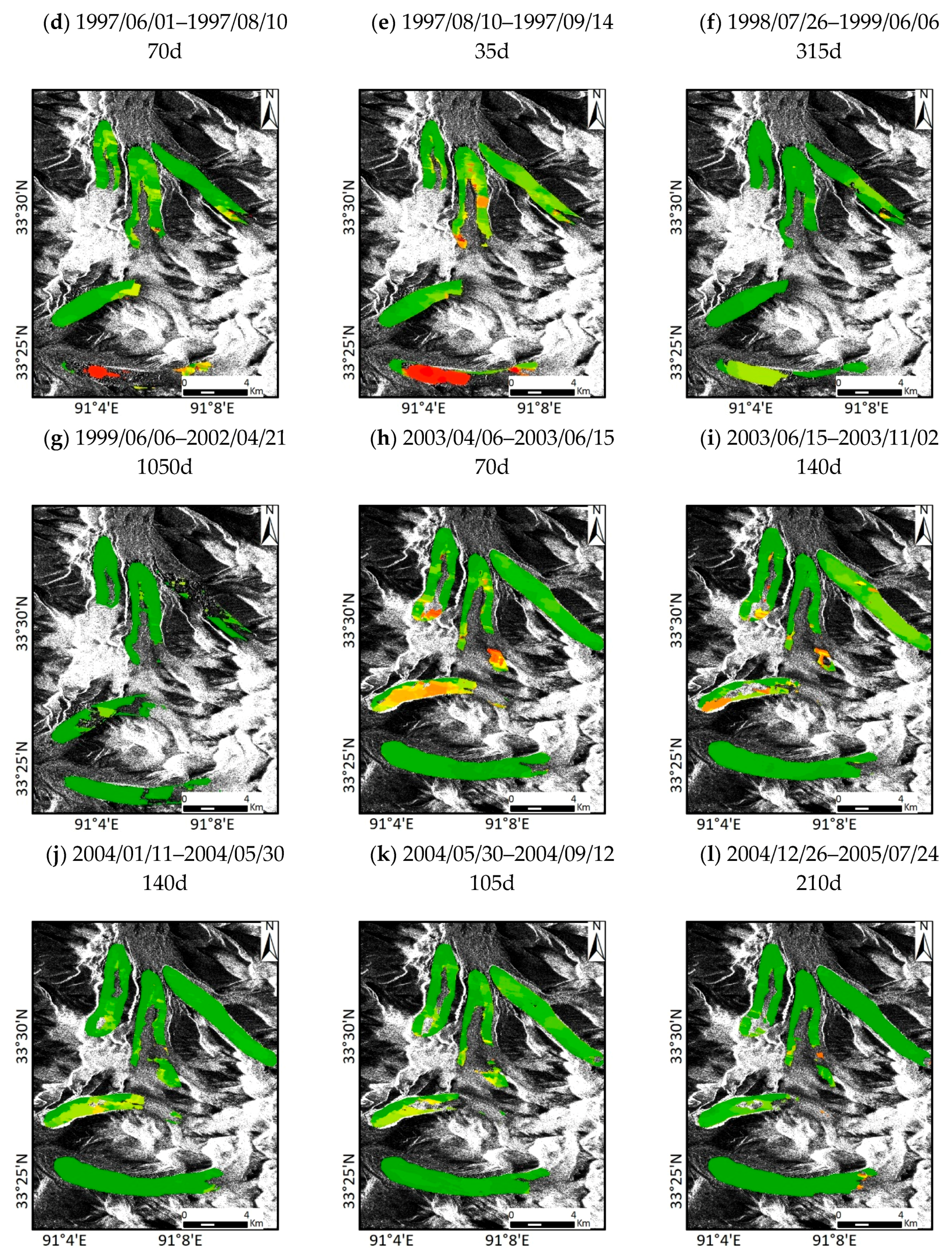
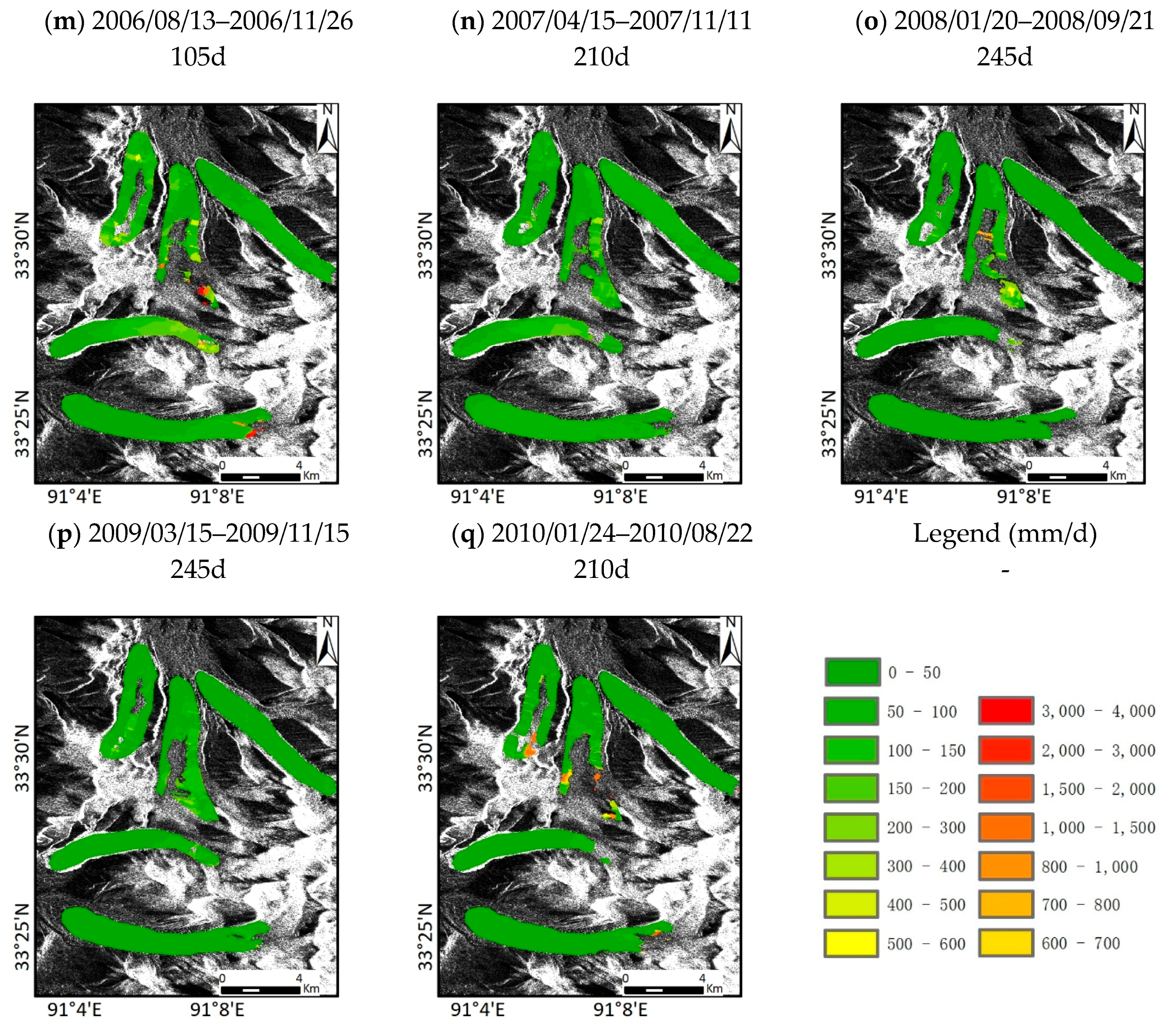
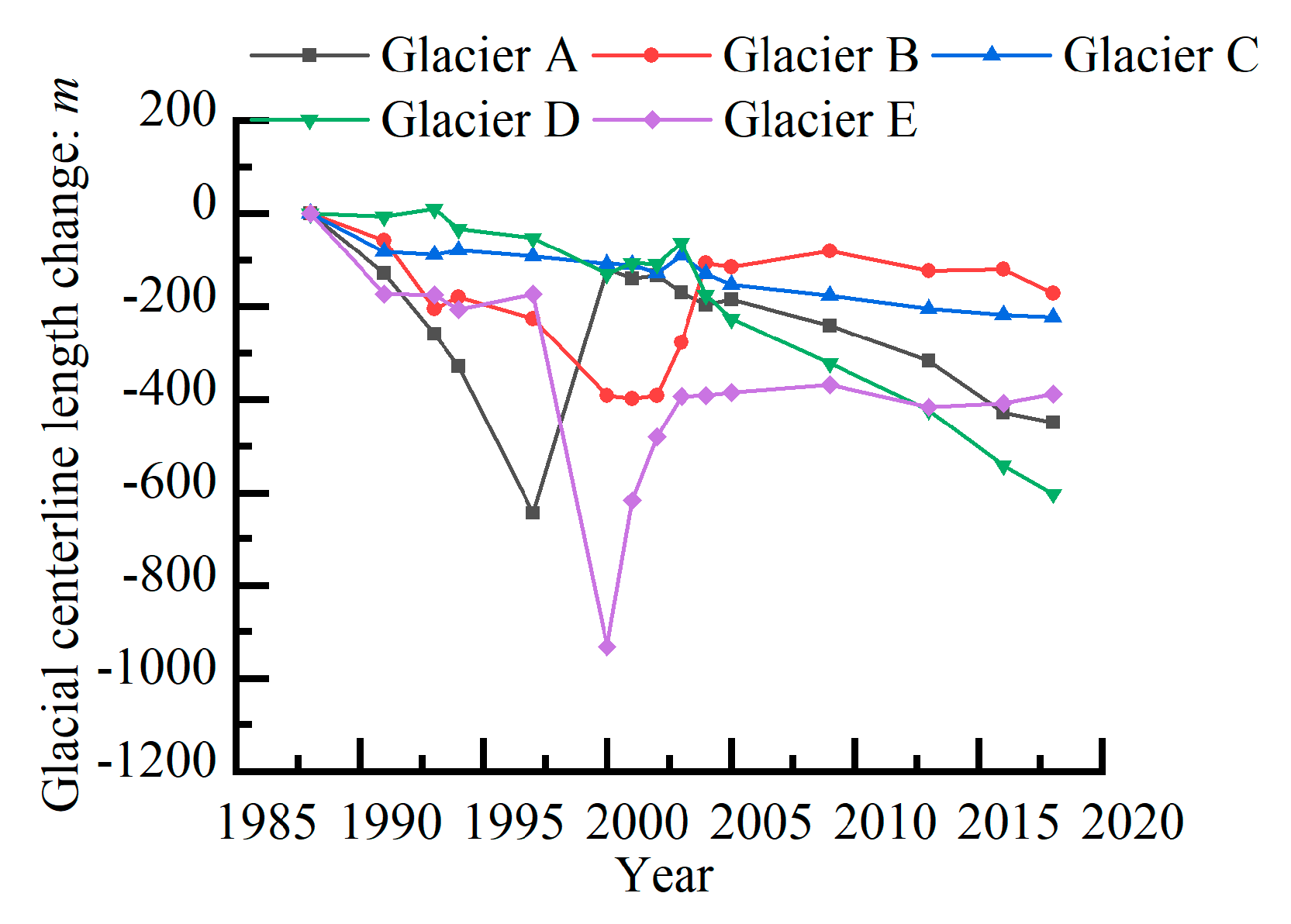

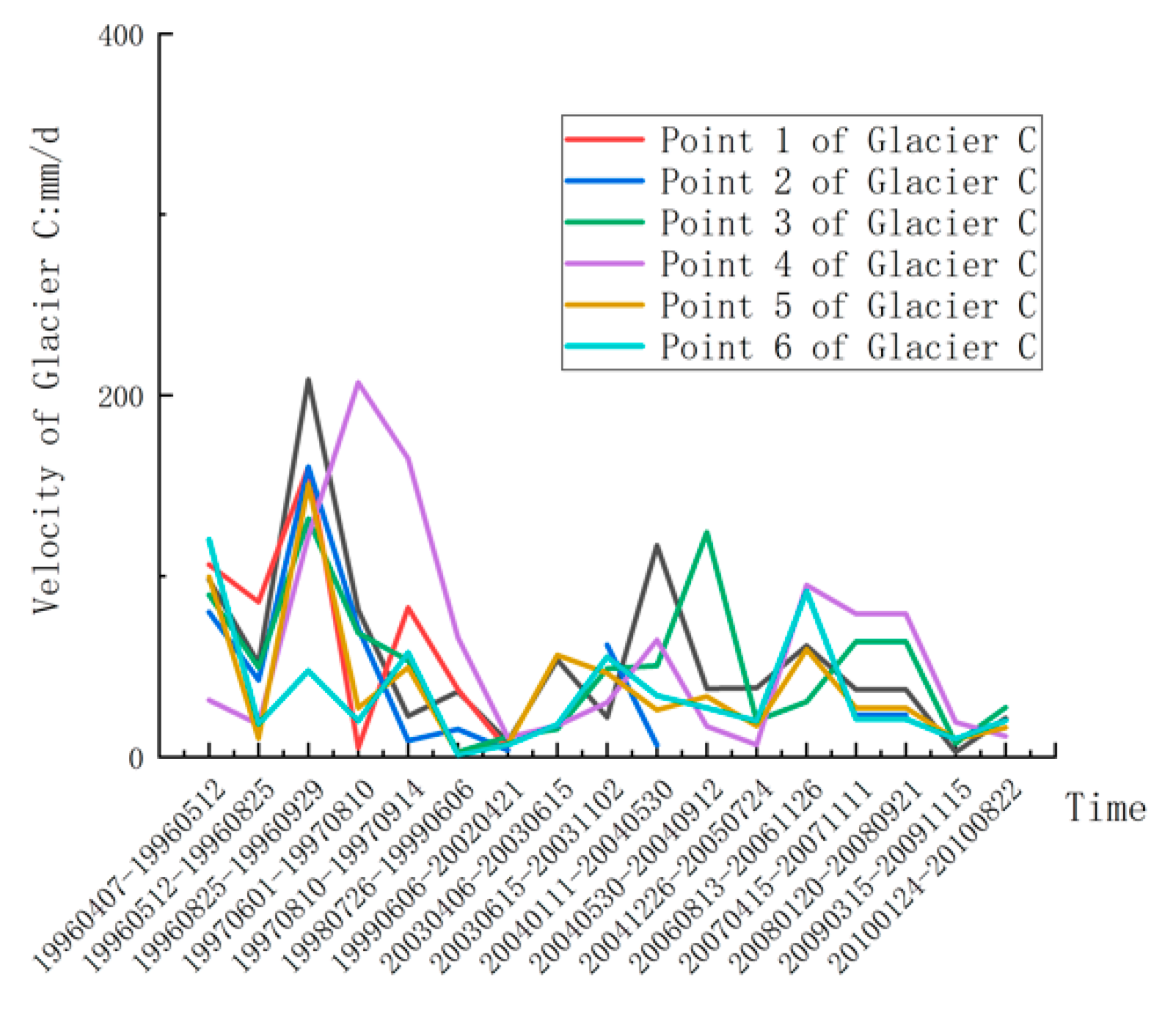
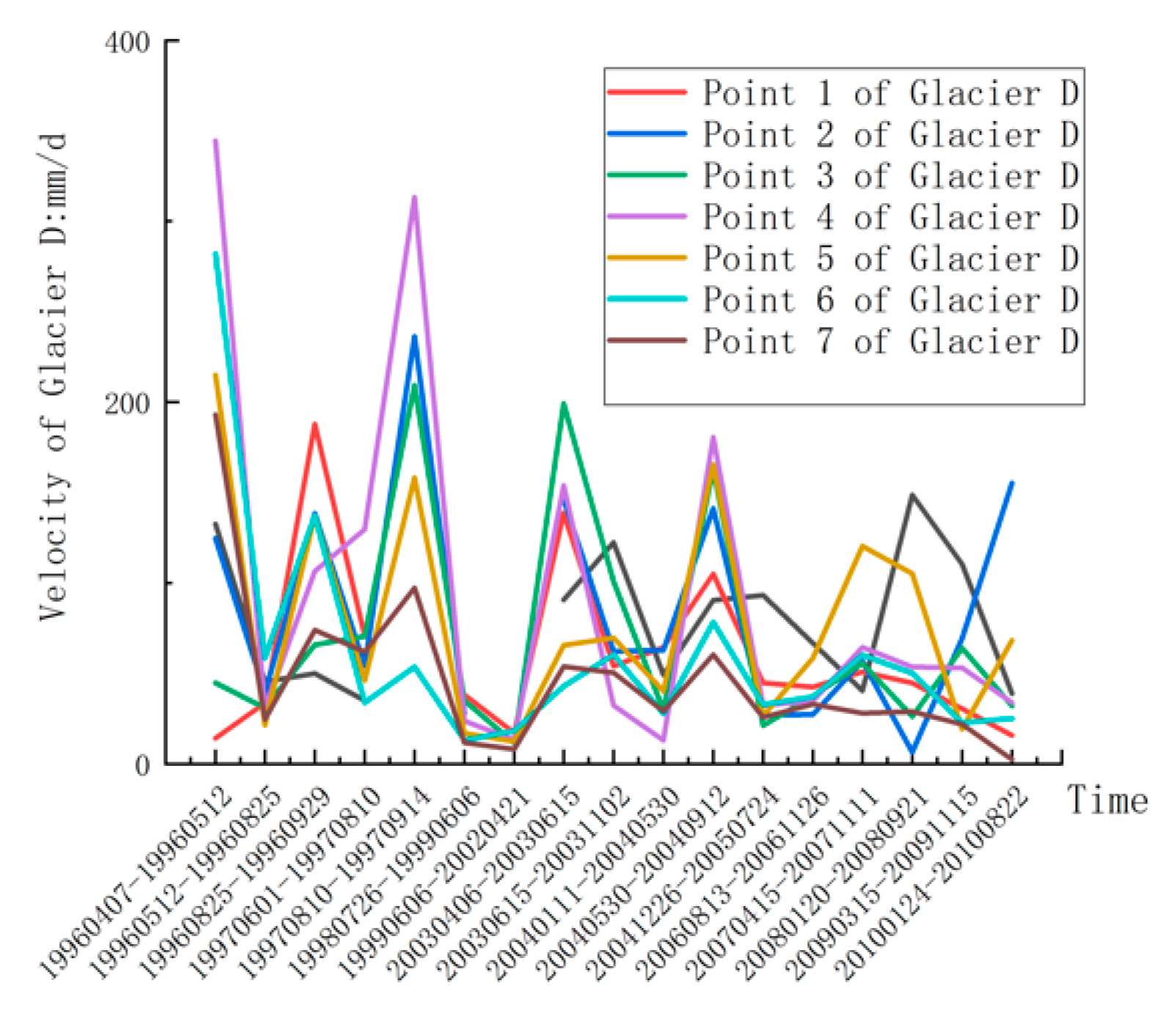
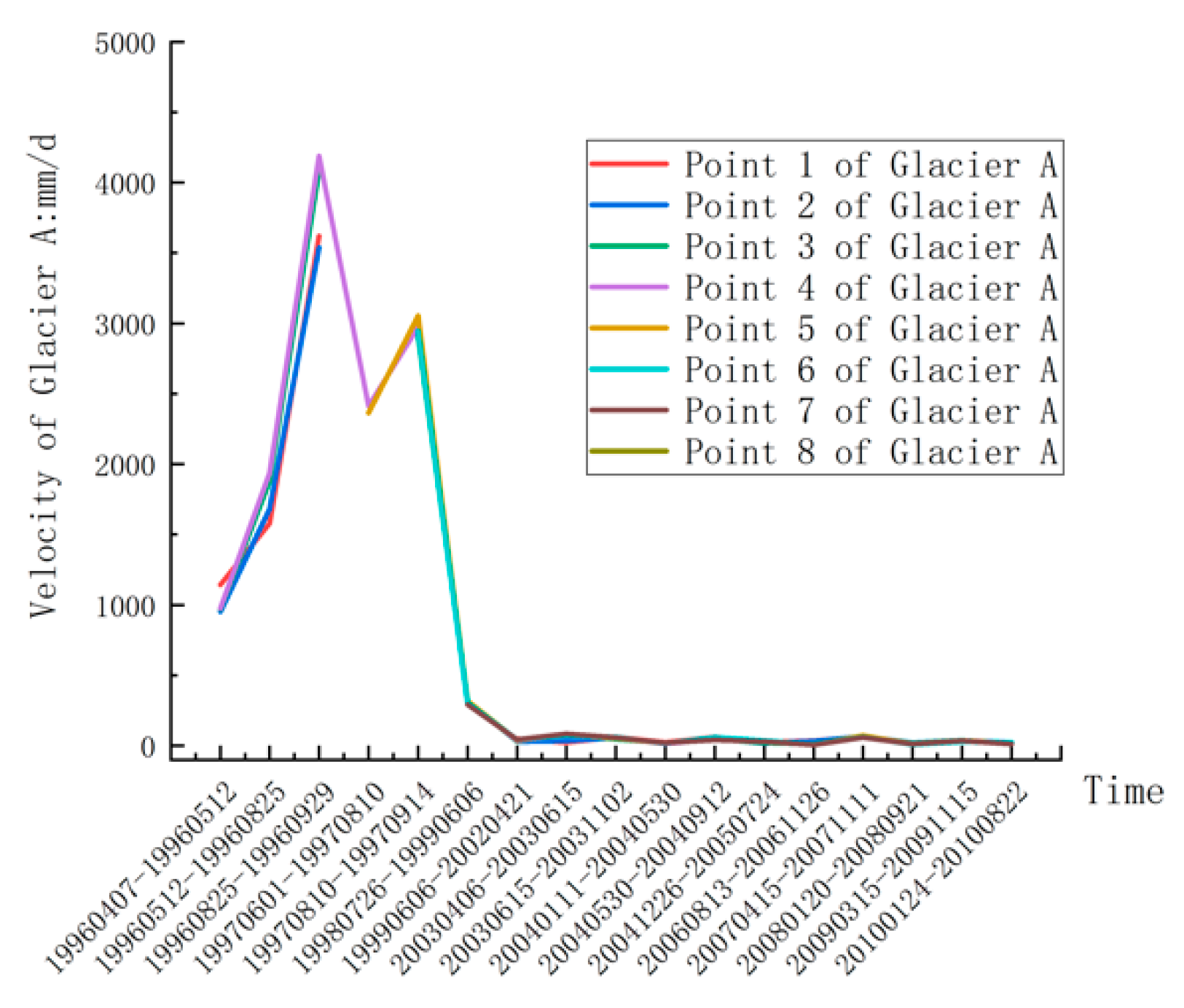
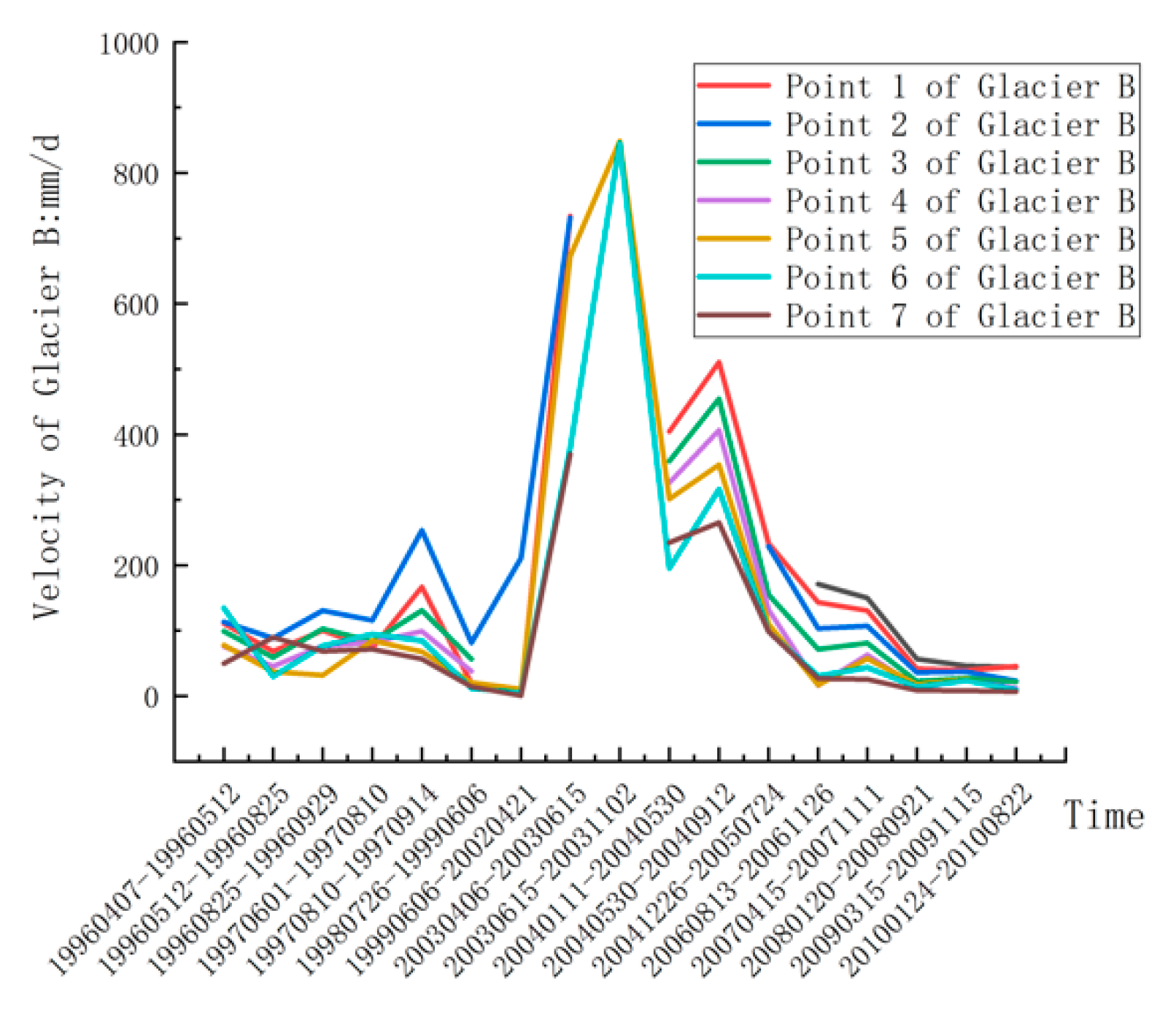
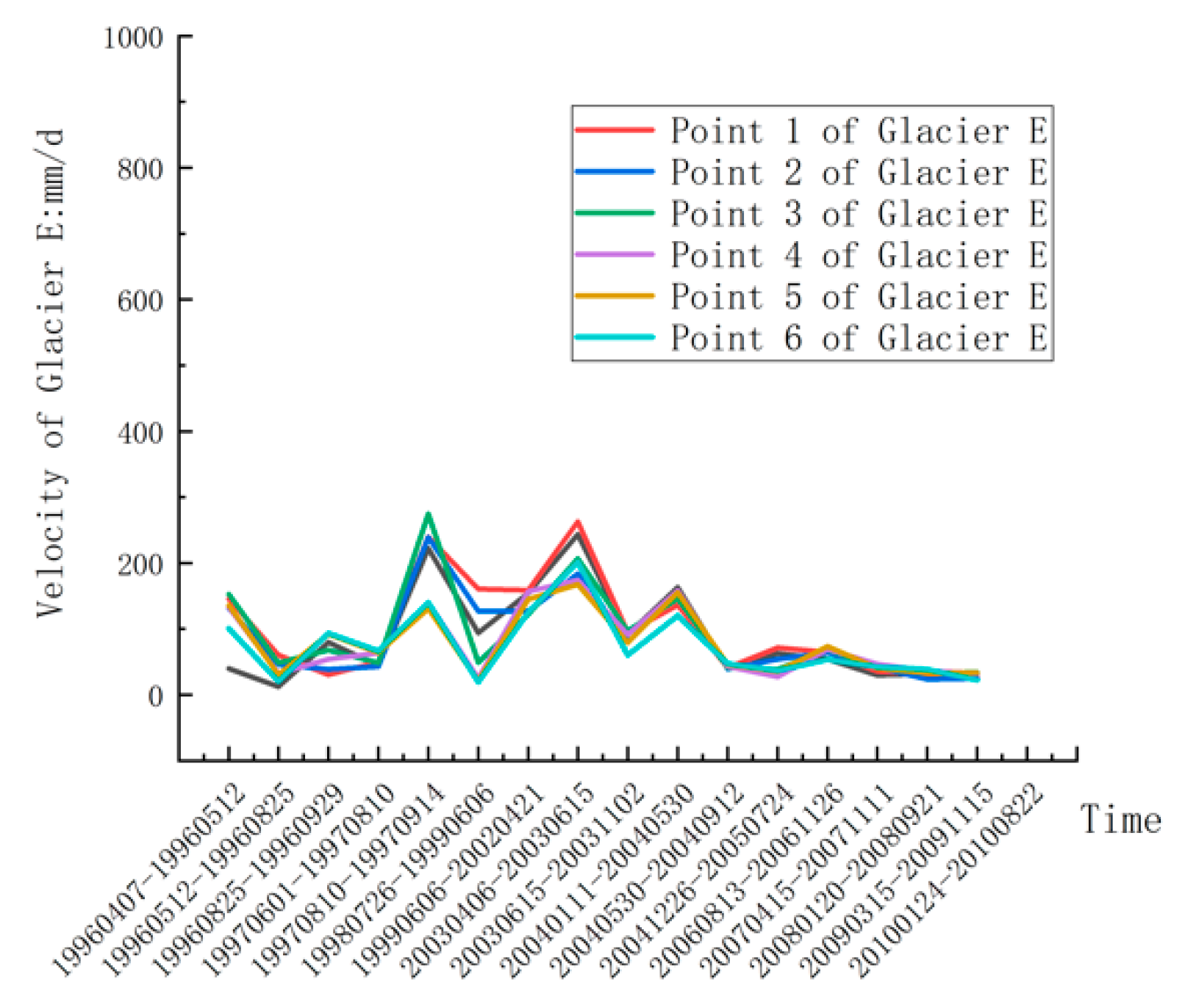


| ID | GLIMS_ID | Gla_Long (°) | Gla_lati (°) | Max_lev (m) | Min_lev (m) | Mean_ lev (m) |
|---|---|---|---|---|---|---|
| A | G091091E33424N | 91.091163 | 33.423696 | 6521.7 | 5386.2 | 5846.9 |
| B | G091071E33463N | 91.071464 | 33.462577 | 6500.0 | 5358.6 | 5841.9 |
| C | G091058E33525N | 91.057776 | 33.525472 | 6006.5 | 5328.7 | 5710.9 |
| D | G091104E33504N | 91.103793 | 33.503539 | 6540.8 | 5352.5 | 5795.6 |
| E |
© 2019 by the authors. Licensee MDPI, Basel, Switzerland. This article is an open access article distributed under the terms and conditions of the Creative Commons Attribution (CC BY) license (http://creativecommons.org/licenses/by/4.0/).
Share and Cite
Yan, J.; Lv, M.; Ruan, Z.; Yan, S.; Liu, G. Evolution of Surge-Type Glaciers in the Yangtze River Headwater Using Multi-Source Remote Sensing Data. Remote Sens. 2019, 11, 2991. https://doi.org/10.3390/rs11242991
Yan J, Lv M, Ruan Z, Yan S, Liu G. Evolution of Surge-Type Glaciers in the Yangtze River Headwater Using Multi-Source Remote Sensing Data. Remote Sensing. 2019; 11(24):2991. https://doi.org/10.3390/rs11242991
Chicago/Turabian StyleYan, Jin, Mingyang Lv, Zhixing Ruan, Shiyong Yan, and Guang Liu. 2019. "Evolution of Surge-Type Glaciers in the Yangtze River Headwater Using Multi-Source Remote Sensing Data" Remote Sensing 11, no. 24: 2991. https://doi.org/10.3390/rs11242991





